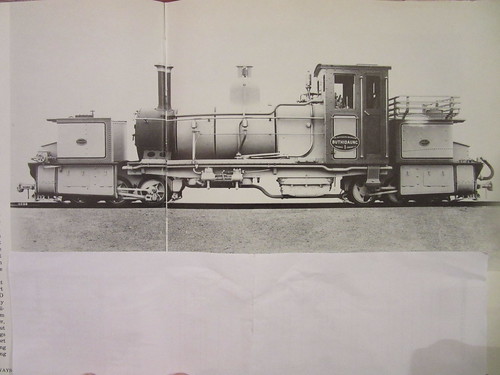 Click here for larger view.
Click here for larger view.0-6-0+0-6-0 Garratt locomotive 'Buthidaung' No. 1 of the Buthidaw-Maungdaw Tramway Company Ltd. built Beyer Peacock, maker's number 5702 of 1913 (Photo: Beyer Peacock).
In Part 3 of Hugh Hughes invaluable guide to railway locomotives in India (introduced here), there is a brief description of the long-gone Arakan Light Railway in Burma (Myanmar), from which this account is derived.
The Arakan Flotilla Company founded the Buthidaung - Maungdaw Tramway Company in March 1913, to construct a 2ft 6in (762 mm) narrow gauge railway between these towns to improve communications in the remote area near Burma's border with what is now Bangladesh.
The consultant was Everard Richard Calthrop (1857-1927) who had worked for Robert Stephenson, the L&NWR, the GWR and the Great India Peninsula Railway before ill health forced his return to England in 1892 where he established a consulting practice.
In 1895 he was Consulting Engineer to the Barsi Light Railway in India (see the Wikipedia article here) where he was able to implement his ideas for effective narrow gauge railways - a combination of 2ft 6in gauge laid with 30 pounds per yard rail and an axleload of 5 Imperial tons on all axles. This proved very successful and his formula was adopted widely, including on the Arakan Light Railway and on the Leek and Manifold Light Railway in the U.K.
There's more information about the man in Grace's Guide here and Wikipedia here.

According to an illustrated booklet published in 1914:-
"The chief object of the tramway is to cater for the enormous inflow of coolies who yearly emigrate from Chittagong into Arakan for the rice harvest and work in connection with the rice mills, and also for the ploughing of the fields and the sowing an transporting of the crop. Many of these coolies travel on foot by overland tracks which converge near Maungdaw and diverge again at Buthidaung, and the Arakan Flotilla's launches bring a large number from Ucha Ghat at the head of the Naaf river down to Maungdaw. When the tramway is built, through tickets will be available right down to Akyab, by tramway and launch. As soon as the present line is in working order, further extensions towards the crowded districts of Chittagong and the roadless tracks of Arakan will be undertaken."This enthusiasm was not shared by the public and in October 1916 Martin & Company of Calcutta registered the Arakan Light Railway Company in order to purchase and complete the line, with support from the Governments of India and Burma and the Arakan Flotilla Company. To cross the Mayu Range, two tunnels and gradients as severe as 1 in 33 were required. The line was just over 18 miles long.
The railway opened on 15th February 1919 but receipts were disappointing and covered only half the expenses, resulting in liquidation and sale to the Indian Government for dismantling.
The line had three locomotives whose fate is not known:-
0-6-0 saddle tank with 21.5 in. dia. coupled wheels and cylinders 7 in. x 12 in. built by W. G. Bagnall, maker's number 1900 of 1912 'Muriel' (no running number).To meet the requirements of a tramway, the four sets of motion were enclosed - possibly the only Garratts so enclosed. They were arranged for left-hand drive and were provided with a vacuum ejector for train braking.There were three water tanks:-
0-6-0+0-6-0 Garratt with 24 in. dia. coupled wheels and cylinders (4) 8.5 in. x 12 in. built by Beyer Peacock, maker's number 5702 of 1913 'Buthidaung' (running number 1).
0-6-0+0-6-0 Garratt with 24 in. dia. coupled wheels and cylinders (4) 8.5 in. x 12 in. built by Beyer Peacock, maker's number 5703 of 1913 'Maungdaw' (running number 2).
280 gallons (smokebox end)These two Garratts were the smallest ever built by Beyer Peacock.
110 gallons (firebox end)
160 gallons (under boiler).
